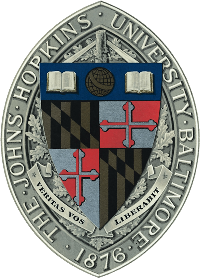Team:Johns Hopkins
From 2010.igem.org
Arjunkhakhar (Talk | contribs) |
SunPenguin (Talk | contribs) |
||
| Line 48: | Line 48: | ||
[[Image:Johns Hopkins logo.png|left|frame|Johns Hopkins University]] | [[Image:Johns Hopkins logo.png|left|frame|Johns Hopkins University]] | ||
|| | || | ||
| - | <big>'''Genetically engineered ''Saccharomyces cerevisiae'' that is responsive to voltage signals at a transcriptional level. </big> | + | <big>'''Genetically engineered ''Saccharomyces cerevisiae'' that is responsive to voltage signals at a transcriptional level. ''''</big> |
| - | + | Using our specifically designed CRZ1 binding elements in tandem with fluorescent reporter genes, we characterized calcineurin-CRZ1 mediated calcium response pathway in yeast. In doing so we have taken the first step in creating an interface between cellular systems and computers by allowing cells to respond to voltage signals, the language of computers. | |
<big>'''Possible applications:'''</big> | <big>'''Possible applications:'''</big> | ||
| Line 56: | Line 56: | ||
*We are looking into creating a URA3 gene (required for uracil synthesis) downstream of our CDRE equipped promoter region, to create yeast cells whose growth is dependent on this gene being transcribed. Thus we plan to have a system where you could text a computer which was hooked up to your eletro stimulation device and you could take cells in and out of the growth cycle, just by simple preprogrammed voltage signals put out by the computer. | *We are looking into creating a URA3 gene (required for uracil synthesis) downstream of our CDRE equipped promoter region, to create yeast cells whose growth is dependent on this gene being transcribed. Thus we plan to have a system where you could text a computer which was hooked up to your eletro stimulation device and you could take cells in and out of the growth cycle, just by simple preprogrammed voltage signals put out by the computer. | ||
| - | *We envisage a voltage activated transcriptional response to be very | + | *We envisage a voltage activated transcriptional response to be very useful in cardiovascular and neuronal research, by it is possible to weed out cells that display only specific action potentials. We hypothesize this could be done by causing a selectable transcriptional response to the calcium influx of the action potential. |
|} | |} | ||
{| | {| | ||
| Line 65: | Line 65: | ||
|-valign="top" | |-valign="top" | ||
| | | | ||
| - | <big>'''Our Accomplishments'''</big> | + | <big>'''Our Accomplishments'''</big><br> |
| - | + | '''We have...''' | |
| - | * | + | *Extended previous work on voltage sensitivity (Valencia 2009) in ''S. cerevisiae'', bringing the response from the biochemical domain into the transcriptional. |
| - | * | + | *Constructed a library of 7 voltage-activated yeast upstream activation sequences with varying sensitivity. |
| - | * | + | *Characterized two full voltage-activated promoters for yeast. |
| - | * | + | *Developed a model to describe the transcriptional response to voltage of our system. |
| - | * | + | *Successfully leveraged post-translational modification machinery, namely phosphorylation of Crz1 by calcineurin, to initiate a transcriptional response. |
| + | *Fabricated a highly accurate microfluidic electro-stimulation setup using gold electrodes on a silicone wafer and are currently in the process of refining the fabrication technique. | ||
|} | |} | ||
[[Image:IGEM_Team_Photo.jpg|650px|center|thumb| JHU iGEM 2010]] | [[Image:IGEM_Team_Photo.jpg|650px|center|thumb| JHU iGEM 2010]] | ||
Revision as of 05:30, 27 October 2010
|
Genetically engineered Saccharomyces cerevisiae that is responsive to voltage signals at a transcriptional level. ' Using our specifically designed CRZ1 binding elements in tandem with fluorescent reporter genes, we characterized calcineurin-CRZ1 mediated calcium response pathway in yeast. In doing so we have taken the first step in creating an interface between cellular systems and computers by allowing cells to respond to voltage signals, the language of computers. Possible applications:
|
|
Team: We are a team of 9 undergraduate students deeply interested in synthetic biology. We hail from a variety of disciplines including, chemistry, biology and engineering. We’re a fresh new team with varying levels of experience united by our passion for science. |
|
Our Accomplishments
|
 "
"


